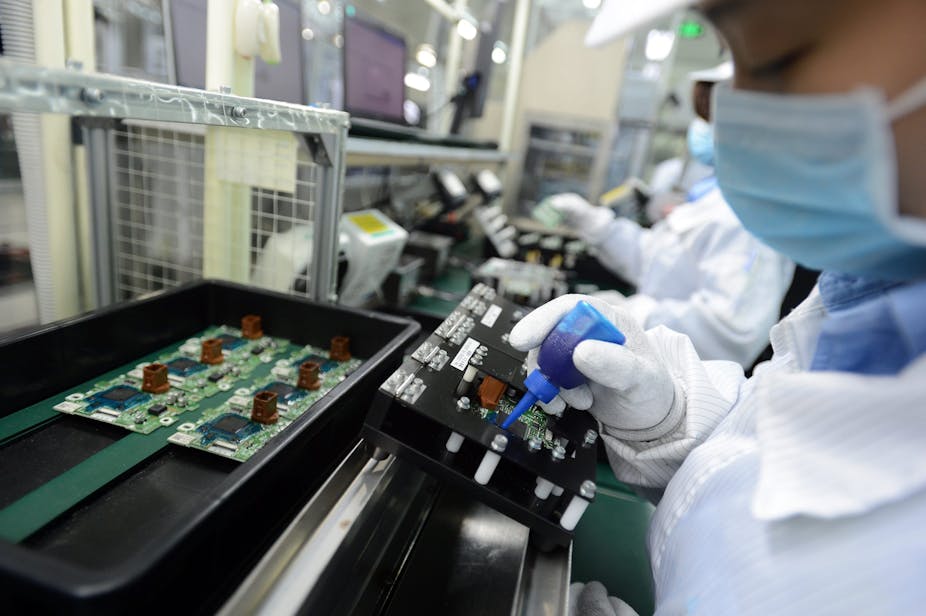As Australia laments the decline of its manufacturing sector, China is actively taking steps to accelerate its move up the value chain.
Historically a low-cost operating environment, China was once an attractive option for multinational companies seeking to minimise production costs. However with a burgeoning middle class aspiring for a better place in the global ecosystem, the cost advantages are rapidly eroding.
A Bloomberg Businessweek article examined how tech manufacturer Knowles has grappled with these changing conditions, and their experiences aren’t unique.
The rapid increase in wages, increased cost of doing business – physical infrastructure and raw material - and a higher Yuan are all contributing to manufacturing cost pressures. These challenges, and the pace at which they are taking place, are forcing multinational companies in China to rethink their local strategy to remain competitive.
For those firms not in a position to move up the cost/quality curve, an attractive option is to shift their operations to other parts of Asia where labour costs are still a fraction of China’s, such as the Philippines or Vietnam.
Increasingly multinationals are also facing hiring competition from local private and state-owned enterprises. Temporary relocations from rural areas to larger cities for work are also common in parts of China, with employees returning to their families after a year or two.
It is no surprise then for companies to be investing in employee engagement programs. In one instance, a leading manufacturer of building products in Guangzhou has made a considerable investment in employee engagement programs to achieve a staff turnover rate of 20% (which they identify as being well below the average at comparable companies).
“Indigenous innovation”
Led by the government’s 9% growth target for the production of sophisticated goods, China has concentrated on improving its business and governance environment to create a high value-adding manufacturing industry, as opposed to its traditional low-cost, low value-added ecosystem.
In doing so, their focus has been on “indigenous innovation” – creative production nationally that is less reliant on foreign capabilities.
Analysis conducted by the Royal Bank of Scotland and Bloomberg indicated a shift in job types away from traditional textile and clothing, to computers and communications. Medium and high-tech goods production has increased from 40-60% over the past two decades.
While China is transforming itself into an advanced manufacturer, India is actively promoting itself as a manufacturing hub. India’s recent 11th Five Year Plan (2007-12) showed 28.5% jobs growth in the manufacturing sector. India plans to create an industrial corridor between Delhi and Mumbai, investing in vital support infrastructure such as power plants, water facilities and transport infrastructure.
Alongside this global manufacturing and trading hub, will be the creation of seven “Smart Cities”, while at the Third Global Innovation Roundtable (GIR) 2013 in Delhi, there was also discussion of incorporating industry-university clusters, as well as virtual clusters.
How can Australia compete?
All this means that Australian manufacturers need to be prepared for increasing competition in higher value manufacturing, and consider a wider range of options when looking to offshore operations.
So where should Australia place its efforts and how does it retain its competitive edge? My recent article on Asian value chains clearly establishes the economic case for Australia to deepen its engagement in Asia. But more needs to be done. UWA Professor Tim Mazzarol’s recent piece on the “big shift” in manufacturing - from controlling assets and stocks to leading global knowledge networks - makes this case too.
This accords with calls by industry minister Ian Macfarlane for Australia to expand its industry base to cover new industries and products and transform relationships between research, skills, training and industry.
This ethos of collaborative competition will serve Australia’s interests well in moving up the value chain of activity, allowing Australian companies to lead new developments.
At the micro level, Australian companies must start to foster an enabling culture that moves individuals from thinking about ‘my’ role to ‘enabling another’s’ role within the company.
But a prerequisite is the creation of a high skilled, globally minded workforce, which needs to begin through schools, universities and even into organisations.
Sustained interventions at different levels of the ecosystem in education, management and industry will enable a national culture that drives future productivity, innovation and entrepreneurship. Education must be the avenue by which we not only prepare individuals for jobs, but help them to become creators of jobs.

